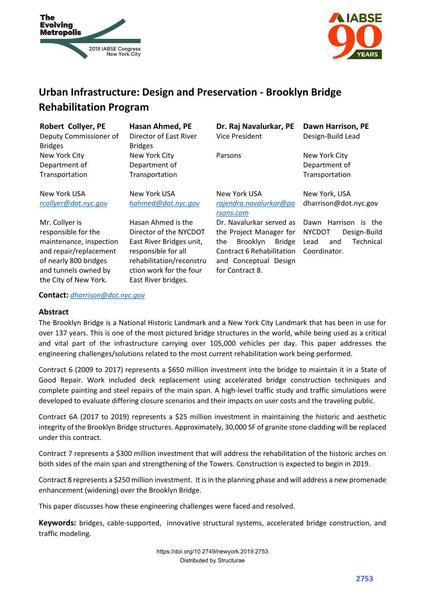Urban Infrastructure: Design and Preservation - Brooklyn Bridge Rehabilitation Program

|
|
|||||||||||
Bibliografische Angaben
| Autor(en): |
Robert Collyer
(New York City Department of Transportation)
Hasan Ahmed (New York City Department of Transportation) Raj Navalurkar (Parsons) Dawn Harrison (New York City Department of Transportation) |
||||
|---|---|---|---|---|---|
| Medium: | Tagungsbeitrag | ||||
| Sprache(n): | Englisch | ||||
| Tagung: | IABSE Congress: The Evolving Metropolis, New York, NY, USA, 4-6 September 2019 | ||||
| Veröffentlicht in: | The Evolving Metropolis | ||||
|
|||||
| Seite(n): | 2753-2759 | ||||
| Anzahl der Seiten (im PDF): | 7 | ||||
| DOI: | 10.2749/newyork.2019.2753 | ||||
| Abstrakt: |
The Brooklyn Bridge is a National Historic Landmark and a New York City Landmark that has been in use for over 137 years. This is one of the most pictured bridge structures in the world, while being used as a critical and vital part of the infrastructure carrying over 105,000 vehicles per day. This paper addresses the engineering challenges/solutions related to the most current rehabilitation work being performed. Contract 6 (2009 to 2017) represents a $650 million investment into the bridge to maintain it in a State of Good Repair. Work included deck replacement using accelerated bridge construction techniques and complete painting and steel repairs of the main span. A high-level traffic study and traffic simulations were developed to evaluate differing closure scenarios and their impacts on user costs and the traveling public. Contract 6A (2017 to 2019) represents a $25 million investment in maintaining the historic and aesthetic integrity of the Brooklyn Bridge structures. Approximately, 30,000 SF of granite stone cladding will be replaced under this contract. Contract 7 represents a $300 million investment that will address the rehabilitation of the historic arches on both sides of the main span and strengthening of the Towers. Construction is expected to begin in 2019. Contract 8 represents a $250 million investment. It is in the planning phase and will address a new promenade enhancement (widening) over the Brooklyn Bridge. This paper discusses how these engineering challenges were faced and resolved. |
||||
| Stichwörter: |
Brücken
|
||||
